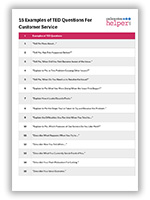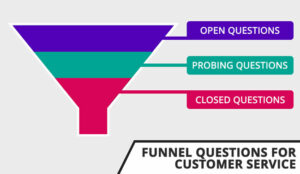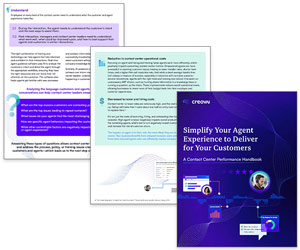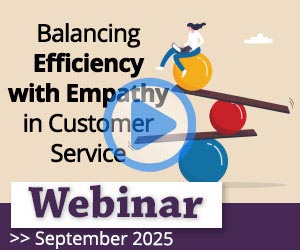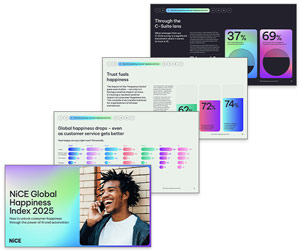Want to uncover customer needs faster and provide better service? TED questions help contact centre agents ask the right questions and get to the heart of customer issues.
In this article, we share some excellent examples of TED questions, which will enable contact centre advisors to offer better customer service.
What Are TED Questions?
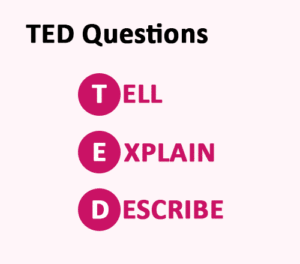
TED (Tell, Explain, Describe) questions are a questioning technique that helps call centre advisors probe for more information from the customer.
A TED question begins with one of these three words/phrases – Tell, Explain, Describe. Such a question allows a contact centre advisor to probe the customer.
After using these questions, the advisor gains critical insights that paint a clear picture of the customer’s issue. If the advisor only asks open or closed questions, it would likely take longer to achieve this aim.
Of course, for transactional call queries, asking only open and closed questions may suffice. Yet, for trickier contacts which require probing, TED questions may provide the perfect tool to clear up grey areas and illuminate critical customer goals.
Just remember to keep this light. Firing these questions at customers can come across as a little overbearing. So, remember to stay empathetic, inject positivity and add the words “could you…” – from time to time – to remain respectful.
Examples of TED Questions for Customer Service
We have put together a list of example TED questions, read on to find out more:
1. “Tell Me More About…”
When a customer introduces their query, they often skip over crucial details. If the advisor feels that this is the case, use this TED question to reflect that detail back to the customer in the hope of learning new, helpful information.
2. “Tell Me, Has This Happened Before?”
If the problem is a recurring issue, the advisor may uncover previous solutions. These often provide insight into how to solve the issue once and for all.
3. “Tell Me, When Did You First Become Aware of the Issue?”
Pinpointing when a problem emerged may help to uncover its root cause. Also, by asking such a question, the advisor understands how long the customer has been suffering in silence. Such an insight may result in a more appropriate resolution.
4. “Explain to Me, is This Problem Causing Other Issues?”
Often, advisors struggle to get to grips with the extent of an issue. Such a question enables them to do so, while they may also be able to offer a more authentic apology and, again, find a more fitting resolution.
5. “Tell Me, When Do You Need us to Resolve the Issue?”
Uncovering the urgency of the request empowers the advisor to ensure that their solution aligns well with customer expectations.
6. “Explain to Me What You Were Doing When the Issue First Began?”
Did the customer mistakenly cause the issue themselves? Such a question will reveal all. Just be a little careful, however, as it may sound accusatory. Perhaps this is a prime example of a TED question to prefix with the words: “Could you…”.
7. “Explain How it Looks/Sounds/Feels.”
Visualizing the situation enables the advisor to get to grips with the issue. It may also allow them to link it to a similar problem they have previously encountered.
8. “Explain to Me the Steps You’ve Taken to Try and Resolve the Problem.”
If the customer suggests that they have already attempted to solve the issue, find out what actions they have taken. Doing so may prevent the advisor from sharing a solution that was previously unsuccessful.
9. “Explain the Difficulties You Ran Into When You Tried to…”
When the customer has already attempted to resolve the issue themselves, discover where they came unstuck. Perhaps their solution has potential yet imperfect execution. Providing a little extra guidance is often the silver bullet.
10. “Explain to Me, Which Features of Our Service Do You Like Most?”
TED questions frequently come to the aid of advisors when dealing with indecisive customers. The example above helps to uncover the personal preferences of the customer. The advisor can use these to lead the customer to the most appropriate solution.
11. “Describe What Happens When You Try to…”
When troubleshooting, an advisor can whittle down a selection of possibilities by asking the customer what happens when they follow particular actions. The outcomes will add greater context to the problem.
12. “Describe How You Felt When…”
Customers don’t only have functional needs. When a problem is especially troublesome, they have emotional needs too.
Employing the statement above enables the advisor to understand these needs and show sincere empathy. Just avoid asking this right away. Most customers will only open up once they are in rapport with the advisor.
13. “Describe What You Currently See in Front of You.”
When a customer throws lots of information at the advisor, it is often best to bring the conversation back to the basics. Asking them to describe what they see is simple. In all likelihood, they will likely answer clearly and coherently.
14. “Describe Your Main Motivation For Calling.”
Such a question is excellent at enabling the customer to clear their thoughts, while the answer allows the advisor to take control of the call and ask more closed questions to simplify the service experience.
15. “Describe Your Ideal Outcome.”
Sometimes, advisors find it impossible to meet the high expectations of customers. In many cases, the advisor has not rationalized their expectations themselves. The question above encourages the customer to do so, enabling the advisor to better manage the resolution process.
Printable – 15 Examples of TED Questions For Customer Service
Do you want to download this to share with your team?
Get your 15 Examples of TED Questions For Customer Service now:
Tips to Improve Advisor Questioning
By following the tips below, advisors will naturally fall into positive habits that empower them to ask better TED questions.
Listen to Learn, Not to Reply
To ask the most pertinent questions, listen closely to the customer. It is easy to formulate a response before the customer has completed their previous answer. In doing so, the advisor often misses crucial details and jumps into assumptions.
Of course, intuition is an excellent skill, which the team will foster over time. However, advisors lose customer trust by over-relying on this skill and failing to listen closely.
Instead, coach advisors to paraphrase the customer before asking another question. Inviting the team to do so encourages them to pay attention to the customer at all times.
Also, encourage advisors to use verbal nods as customers respond. Doing so helps to convey that the advisor is listening.
Such an approach is critical, as customer service specialist Myra Golden suggests: “When you can make the other person feel that I hear, I understand you, I get it – then, they are in the perfect position to understand you.”
Patience Will Unlock the Best Solutions
Too often, an advisor will think of a question to move the conversation forwards before the customer gets everything off their chest. Of course, this may result in a speedy resolution. Yet the rep may fail to fulfil the emotional needs of the customer.
Such a situation brings to mind a quote from the famous industrialist Jean Paul Getty: “Patience; this is the greatest business asset. Wait for the right time to make your moves.”
Let the customer vent, empathize with them, and then move the conversation forwards with a question. When the advisor does so, they meet both the functional and emotional needs of the customer.
Remain Courteous at All Times
Asking one TED question after another can cause the customer to feel as if they are in an inquisition. Such an approach is not conducive to excellent customer service.
When a complex query arrives, encourage advisors to tell the customer they are about to ask them a series of questions to get to the bottom of the issue. Doing so is courteous and helps to set the right expectations.
Also, coach advisors to intersperse courtesy words such as “please” and “thanks” between their questions. They can then set a pragmatic, positive tone for the remainder of the conversation.
Tone of Voice Is Vital
Sometimes TED questions seem cooperative and supportive. Other times they come across as terse. The difference is all in tone of voice.
Of course, there are many components within tone of voice. For example, there is pacing, emphasis, volume, etc. However, it does not have to be so complicated. It is easy to tell when an advisor has a tone problem in call listening sessions.
For some advisors, they may just have experienced a bad day. For others, however, the problem runs deeper. Fortunately, it is a problem that is often easy to resolve.
By simply engaging in side-by-side listening to call recordings, most advisors will realize the errors of their ways for themselves. When they do, suggest some tricks, such as sitting up straight and “smiling while dialling”. These may make all the difference.
Learn more secrets to success for customer service questioning by reading our article: 10 Effective Questioning Techniques for Customer Service
Apply Probing Techniques
TED questions enable contact centre advisors to probe into customer issues. By doing so, they can unlock clues and solve problems.
Often used as probing questions within “The Funnel Technique”, these questions will likely follow open questions. Why? Because they allow the advisor to focus on specific details within the customer’s response.
To maximize the value of TED questions, employ good listening skills, patience and a friendly tone of voice. All of the above will likely equate to excellent customer service.
If you want more ideas to improve contact centre conversations, read these articles next:
- Top 25 Positive Words, Phrases and Empathy Statements
- The Phonetic Alphabet – A Simple Way to Improve Customer Service
- Customer Service Skills: How to Improve Empathy, Active Listening and Knowledge
Author: Charlie Mitchell
Reviewed by: Hannah Swankie
Published On: 5th Jan 2022 - Last modified: 14th Aug 2025
Read more about - Skills, Charlie Mitchell, Customer Service, Editor's Picks, Language, Questioning Techniques, Skill Development, Soft Skills







